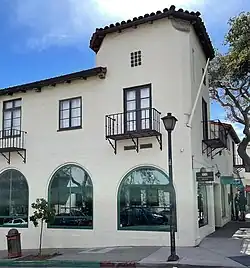James Cooper Doud
James Cooper Doud (May 17, 1902 – August 30, 1984) was an American businessman and real estate developer in Carmel-by-the-Sea, California. He established the Doud Building in 1932, built by master builder Michael J. Murphy. He also owned The Doud Arcade, a two-story commercial building built in 1961 that connects with The Doud Craft Studios.
James Doud | |
|---|---|
 | |
| Born | James Cooper Doud May 17, 1902 |
| Died | 30 August 1984 (aged 82) Honolulu, Hawaii, US |
| Occupation(s) | Businessman, real estate developer |
| Spouse | Frances Lillian Allen |
| Children | 3 |
Early life
Doud was born on May 17, 1902, in Monterey, California, in a house built by his pioneering grandfather, Francis Doud, who arrived in Monterey in 1845. His father was Thomas Doud and mother was Margaret Boland. In August 1920, Doud applied for a U.S. application for a Seaman's protection Certificate. This allowed him to depart from the port of San Francisco.[1]
Doud was engaged to Leslie Thorne in Chicago in 1926 but the engagement was called off.[2] Doud attended Stanford University in 1927, where he played on the college football team.[3][4]
Doud married Frances Lillian Allen on July 28, 1928, in Reno, Nevada.[5] They had a son, Toland "Toley" Sharon Doud,[6] and a daughter Stephanie Margaret (Peggy) Doud. Doud also had a son outside of marriage.[3][7]
Career
After college, Doud worked in real estate for the Del Monte Prosperities Company out of the Hotel Del Monte. In the late 1920s, he worked for William Wrigley, the chewing gum industrialist, and was sales manager for the Arizona Biltmore resort project, in Phoenix, Arizona. He moved to Santa Barbara, California to operate a men's clothing store. After the death of his father in 1929, he returned to Monterey to run the family ranches near King City, California and the old Soberanes Ranch, below Carmel Highlands, California.[3]
Doud was active in the development and sale of subdivisions in and near Carmel, which included Paradise Park, a 17 acres (6.9 ha) site east of Carpenter Street and north of Ocean Avenue. In February 1940, Paradise Park was acquired by Doud and attorney William L. Hudson. Doud and Hudson filed a subdivision map in April 1940. Throughout the 1940s, they promoted Paradise Park and sold lots, with streets named for early pioneers, Honoré Escolle, George Sterling, and Perry Newberry.[8][3]
Doud joined Corum Jackson as a partner in the Carmel Realty Company. He also was involved in the subdivision and marketing of the Mission Fields Tract, the Walker Tract, and Rancho Rio Vista.[3]
Buildings

Doud was a major real estate developer in downtown Carmel. In 1932, Doud established the Doud Building, built by master builder Michael J. Murphy as a mixed-use retail shop and residence.[9][10]

Doud built The Doud Arcade, a two-story commercial building built in 1961 in downtown Carmel. Plans were submitted to the Carmel planning commissioners by architect Robert Jones in September 1960.[11] Doud retired in 1969.[9][12]
Death
Doud died on August 30, 1984, in Honolulu, Hawaii. He was buried in the Monterey City Cemetery in Monterey, California. Funeral services took place on September 8, 1984, at the Santa Rosa Lia Chapel at the San Carlos Cemetery.[3]
References
- "Historical Information for James Cooper Doud". FamilySearch. Retrieved 2022-10-19.
- "Stanford Man Of Carmel Wins Eastern Belle". Oakland Tribune. Oakland, California. 3 May 1926. p. 612access-date=2022-06-14.
- "James Cooper Doud". Carmel Pine Cone. Carmel-by-the-Sea, California. 1984-09-13. Retrieved 2022-06-14.
- "Stanford Alumni 1891-1955". Stanford University, Stanford Alumni Association. Stanford, California. 1927. Retrieved 2022-10-20.
- "Flying to Nevada Grandchild of Sharon Weds". Reno Gazette. Reno, Nevada. 28 Jul 1928. p. 8. Retrieved 2022-10-20.
- "Toland Sharon Doud" (PDF). Carmel Pine Cone. Carmel-by-the-Sea, California. March 30, 2007. p. 39. Retrieved 2022-06-14.
- "The Sharon Families in California" (PDF). billputman.com. March 31, 2010. Retrieved 2022-10-20.
- Neal Hotelling (March 5, 2021). "Paradise Park was there before the town. Where did it go?" (PDF). Carmel Pine Cone. Carmel-by-the-Sea, California. p. 23. Retrieved 2022-06-14.
- Dramov, Alissandra (2019). Historic Buildings of Downtown Carmel-by-the-Sea. Carmel-by-the-Sea, California: Arcadia Publishing. pp. 45, 85, 92. ISBN 9781467103039. Retrieved 2022-06-14.
- Richard N. Janick (February 21, 2003). "Department Of Parks And Recreation" (PDF). National Park Service. Retrieved June 13, 2022.
- "Planner's See Doud Plans For 2 Story Ocean Ave. Arcade". Carmel Pine Cone. Carmel-by-the-Sea, California. 1960-09-22. p. 1. Retrieved 2022-10-20.
- Hale, Sharron Lee (1980). A Tribute to Yesterday: The History of Carmel, Carmel Valley, Big Sur, Point Lobos, Carmelite Monastery, and Los Burros. Santa Cruz, California: Valley Publishers. pp. 6, 37, 120. ISBN 9780913548738. Retrieved 2022-06-14.